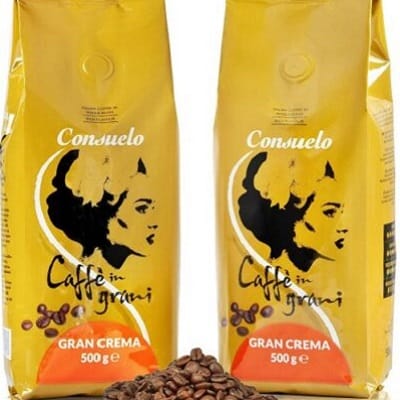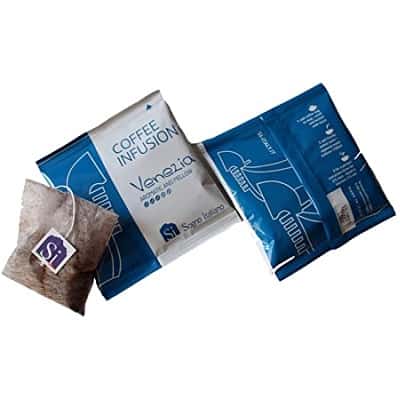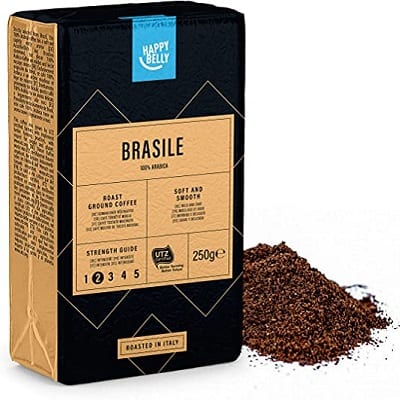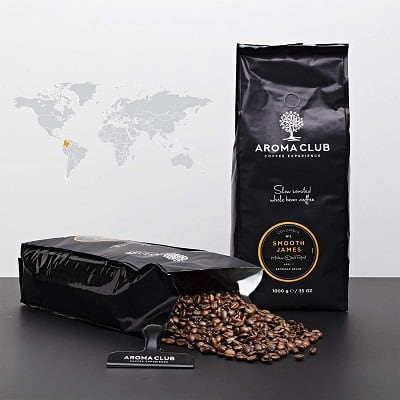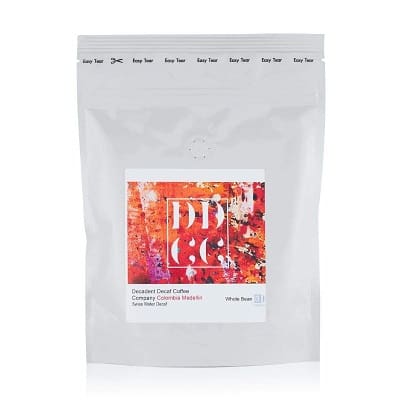You have just woken up at the crack of dawn, your uncontrollably yawning as you descend the stairs. And the only thing your half sleepy mind can focus on right now is that beautiful aroma and taste of a freshly brewed coffee.
Can you image the horror then, when you go to grind the beans and find that your grinder is not working? No at some point since yesterday morning it went to grinder heaven.
It doesn’t matter if you own an automatic bean to cup machine with an integrated grinder or you have a stand alone option, they are all capable of going on the blink at the worst possible moment.
So you now have two choices…
1 – Get in the car and head to the local high street coffee shop for a half decent brew, still in your dressing gown and scarring the normal people
or
2 – Summon up your inner survivalist and get through this
Nobody wants option 1, least of all other members of society, so luckily for you I have put together the ultimate guide on how to grind coffee beans without a grinder, using just everyday kitchen utensils and a little effort.
So go grab your bag of fresh coffee beans and a few simple kitchen utensils, and lets get to work
Mortar and Pestle
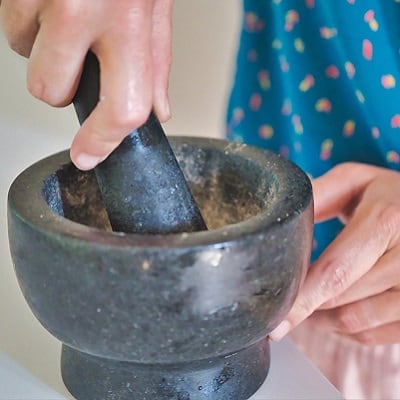
Most modern kitchens will have a Mortar and Pestle, in fact most kitchens for centuries have had a mortar and pestle in them(1). This method of grinding things replaced the ancient method of rubbing between two rocks.
One reason this is so popular as a coffee grinder, is with just a little effort and elbow grease, you can actually achieve a extremely fine grind level and with a consistency that is on a par with the best coffee grinders.
How to use a Mortar and Pestle to grind coffee beans
- Place a small amount of fresh coffee beans into the mortar, fill roughly a quarter way max
- Make sure you have a firm grip of the mortar with your strong hand, this is important, you don’t want it to slip when we start and spill
- Holding the pestle in your other hand, use it press down on the beans. Use a twisting motion to breakdown the stubborn beans
- Once you have broken up all the beans, use a rolling motion around the mortar until you have achieved the desired level of coarseness.
- Be careful not to over rub, you can’t undo it if you go to far.
- Repeat with another batch until you have enough ground coffee.
Pro Tip : Stop and check the coarseness regularly, you will be surprised how fine you can get them using a mortar and pestle
This is a great method to achieve a fine consistency required for an espresso grind
Blender
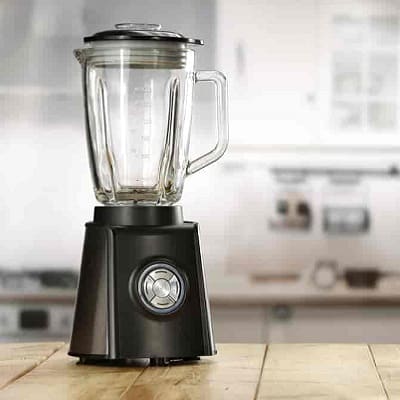
With the recent rise in juicing, and healthy living, most kitchens will also own a blender. Luckily they are not limited to just juicing up carrots and green leaves, no they can also be used to grind up your coffee beans.
Well I say grind, what I really mean is chop, a blender has a rotary blade system that will actually cut up the coffee. This is similar to the way some cheaper coffee grinders (think blade grinder). Unlike a burr coffee grinder, using a blender or blade system will only achieve a coarse grind.
Nb, check if your blender has a coffee grind setting, some do.
How to use a blender to grind coffee
- Place your coffee beans into the grinder, you can be quit liberal this time
- Select the grinder mode, or medium if you don’t have a coffee grinder setting
- Using a pulse setting, grind the beans until the are all ground up
- Shake gentle between pulses to make a more even grind
- Repeat if you need more beans
- Thoroughly clean the blender, otherwise your juices will have a coffee hint for weeks
Safety first : Make sure you have securely closed the lid on the blender to prevent the coffee grounds from flying out.
Food Processor
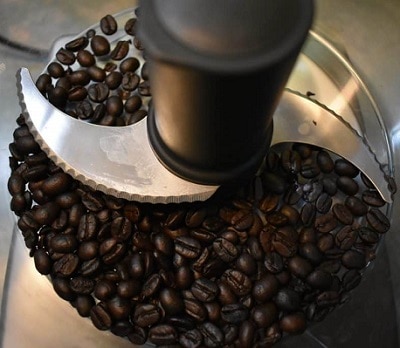
A very similar method to the blender as described above, is the food processor. There will be one lying around somewhere in the back of a cupboard.
If you have a choice then I advise either of the above methods over the food processor. The reason being you will have even less control over the coarseness.
But if you have no other option, then with a little effort you can get a half decent grind
How to use a food processor to grind coffee
- Place your coffee beans in the processor, you can easily get enough in for several cups of coffee
- Use the pulse setting to grind the beans. Pulsing will be easier on the coffee, and ensure they don’t overheat, which will make them bitter
- Shake gentle between pulses to move the larger pieces into the blades path
- Thoroughly clean the processor to remove any aroma of coffee.
Zip Lock bag :
Not every kitchen will have a blender, food processor or mortar and pestle, you may staying away from home in rental or on vacation in a caravan, but this shouldn’t mean you have to miss your daily hit of fresh coffee.
So how to grind coffee beans if you find yourself in that situation, well you should have one of the below items to hand, but if not then any heavy blunt object, that you don’t mind bashing about (not your ipad) will do.
You will also need a zip lock bag or freezer bag.
The first thing you will need to do is add the required amount of coffee beans to your freezer bag, squeeze out as much air as possible and make sure it is sealed closed. Make sure to spread the coffee beans out.
Optional : cover the bag with a tea towel, it will dampen the noise and help protect the kitchen counter
Rolling Pin
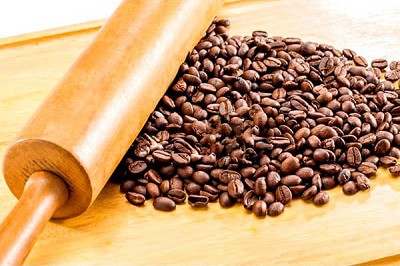
Rolling pins come in all different sizes and materials, if I had to pick the best for the job in hand, then I would favour the marble ones. You know what I mean the big heavy one, it doesn’t need to be marble just have a bit of weight to it.
But to be honest any rolling pin will let you grind your beans without a grinder.
This maybe obvious to most people, but the reason its called a rolling pin, is because its best used, by rolling it. It is not a hammer so don’t use it as one.
How to grind beans with rolling pin
- Place beans in a freezer or any other sealable bag and close
- Wrap the bag in a tea towel to protect the beans
- Roll the pin over the beans while also pushing down to break them up
- Continue rolling over the broken beans until you achieved the required consistency
When rolling, place the bag flat with the zip end towards you and then roll away. If you do this the other way around you may force all the beans out and make a mess.
With a little time and effort you can achieve a fairly fine level of coarseness on your coffee grounds, certainly fine enough to make a half decent espresso.
Hammer
It may seem a little barbaric and harsh to use a hammer to grind your coffee beans, but if you do it correctly then you will avoid damaging them.
It is worth noting it is not possible to obtain the fine grind you need for an espresso. Instead you will have a very coarse and sometimes uneven grind best used for a French Press or drip coffee makers.
How to use a hammer instead of a coffee grinder
- Place a small amount of coffee beans into the bag, do not overfill
- Wrap the bag in a protective towel, do not skip this step.
- Place on top of a cutting board to protect the counter top
- Gently hammer the large beans to break them up
- Use the hammer head to crush the beans to break up further. Do this by pressing down, not a hammering motion.
Pro Tip : You are not hammering a 6″ nail into the wall, be gentle treat your beans with respect, well as much respect as you can before hammering them.
Meat Tenderiser
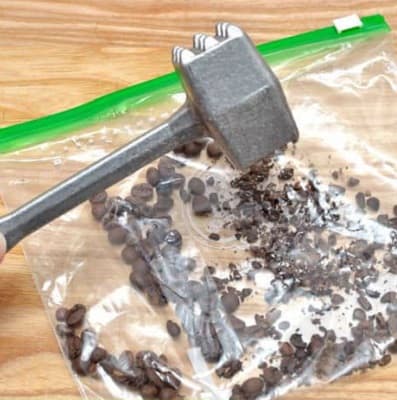
For those that don’t know what a meat tenderiser is, then it is a small metal (sometimes wooden) hammer like device, that is used to beat out meat and make it more tender before cooking. Unlike a DIY hammer, the head is covered in little bumps.
As with the hammer you will only achieve a quite a coarse ground coffee.
How to use a Meat Tenderiser to make ground coffee
- Place a small amount of coffee beans into the bag, do not overfill
- Wrap the bag in a protective towel, do not skip this step.
- Place on top of a cutting board to protect the kitchen worktop
- Gently press the tenderiser down on the large beans to break them up
- Use the tenderiser to crush the beans to break up further. Do this by pressing down, not a hammering motion.
Knife
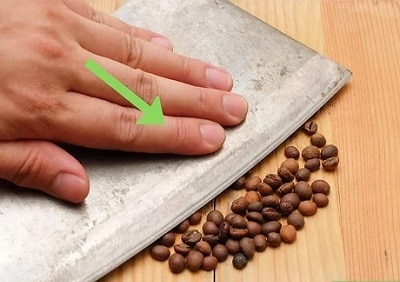
You will be surprised by the level of control you can have when using a knife instead of a coffee grinder. I am not for one minute suggesting you use the sharp edge to cut your beans into fine coffee grounds, no you will use the flat edge as a crushing surface.
I will point out the obvious then and say you need a knife with a large flat edge, such as a butcher knife or an Asian cleaver knife. A small fish filleting knife will be completely useless for this task
How to grind coffee with a knife
- Place a small amount of beans on a chopping board (only do a small batch at a time)
- Place the flat edge of the knife on top of the beans, placing the sharp edge away from you
- Press down firmly to crush the beans
- Repeat on until ALL beans are broken up
- Then drag the knife (Sharp edge away) over the beans to grind them further
- Repeat until you have achieved the desired level of coarseness
Coarseness and Consistency
You will have noticed that each of the methods described will allow you to achieve different levels of coarseness, and if you want a really good cup of coffee then you need to choose a brewing method that matches the coarseness.
Another very important consideration is consistency, which has always been the secret to making a barista quality coffee. You want to make sure the ground coffee you are using has a consistent grind. You do not want some fine, some medium and some coarse, this is the quickest way to bad coffee.
So spend a little more effort getting that consistency, you will be rewarded.
The Final Word
Ultimately your are much better using a burr coffee grinder, as these will give you the ultimate control over the coarseness the the desired consistency.
But as the article started, from time to time you may find yourself with no access to a working option. and then you have to use one of my alternate methods to grind your coffee beans.
In these times then I highly recommend the mortar and pestle, these will give as close a control as a grinder. Use a ceramic one where possible as they are easier to keep clean and stop cross contamination between uses. The last thing you want is a coffee flavoured pesto or even worse the other way around.
There really is no need for instant coffee
FAQs
What is the best way to grind coffee beans?
The best way to grind coffee beans is by using a burr grinder. These will apply an even pressure and grind your beans to an even consistency. Burr grinders also work at a low speed, which means your beans are not spoiled by any heat.
The options described in this article are for when you do not have access to a burr grinder, they are not a replacement.
Can I grind coffee beans in a blender?
Yes you can use a blender, in fact some blenders have a grinder setting. This will work more like a blade grinder. You can only really achieve and coarse level so is only good for a french press or a filter coffee maker.
Does a finer grind make stronger coffee?
The finer the ground coffee, the larger surface area, so for some brewing methods a finer grind will make allow more of the coffee flavours and caffeine to infuse.
For bean to cup and espresso machine and finer grind will slow the flow of water through the group head, making a longer brew and stronger flavour.
Just remember some methods such as French press do not work well with finer grind levels.
How much should you grind at a time?
In all circumstances I always advise you only grind the amount of beans you need at the time. This is ensures maximum freshness.
When you are without your burr grinder, you maybe more tempted than ever to do a whole batch in one go to last a week or until you get a replacement. Please do not do this, these are already second rate grinding methods and will release more oils than normal.
Can you brew whole bean coffee?
I know what your thinking here, your burr grinder is broken and you can’t be bothered with the effort required to grind the beans described above. Then you have an idea “I will just brew whole beans”
Well technically you can brew coffee using whole coffee beans, but as they have a much smaller surface area the brew time will take much much longer. In fact your coffee will be stone cold by the time its brewed.
It may not seem it at first glance but believe me, it is much easier to grind up some beans not matter your brewing method.

